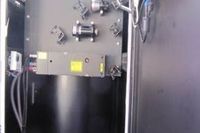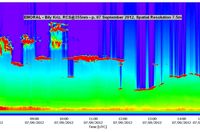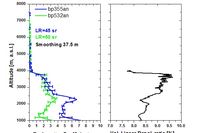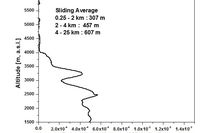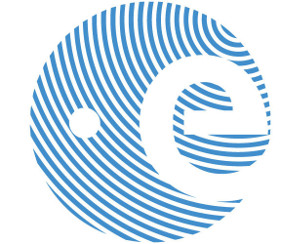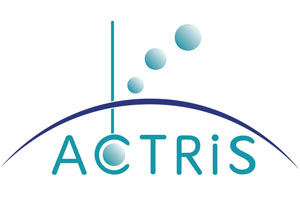EMORAL mobile lidar
| PI | Vassilis Amiridis |
| Participant | National Observatory of Athens |
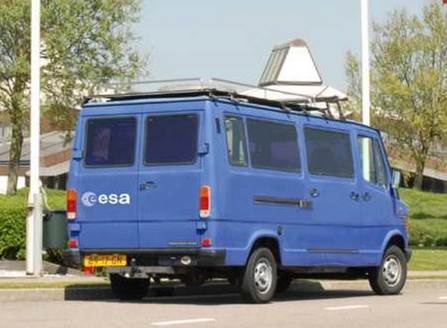
EMORAL lidar will be employed for the implementation of multi-wavelength backscatter, extinction and depolarization observations. These measurements will be used for the characterization of the lofted aerosol plumes, since the overlap of the system is of the order of 0.8 km. The system will be also utilized for measurements outside Finokalia to examine the horizontal homogeneity of the aerosol abundances.
EMORAL (ESA’s Mobile Raman Lidar) is a portable depolarization – Raman lidar, mounted in a minivan, capable of detecting polar and cross-polar signal at 355 and 532 nm, total linear polarized signal at 532nm and nitrogen’s Raman return at 387nm.
The emitter consists of three subunits, the laser source the reflective mirrors and the beam expander units. The laser source is a pulsed Nd:YAG laser (CFR 400) operating at 1064 nm (145mJ), 532 nm (120mJ) and 355 nm (72mJ). The pulse repetition rate is 10Hz and the pulse FWHM is 8.3 nsec. The beam divergence at 86.5% of energy is 0.8mrad for both second and third harmonics before the beam expanders. The beam expander unit contains two expanders with beam expansion factor x 4, for the two wavelengths of interest (355 nm, 532 nm). This reduces the beam divergence of the two beams down to 0.2 mrad at the exit windows of the system (separate windows for each wavelength, symmetrically positioned on one side of the telescope).
The receiving system consists of a Cassegrainian telescope and the wavelength separation/detection optical box. The diameter of telescope’s primary mirror is 400mm and the focal length 4000mm, coated with HR coatings and with very small thermal expansion coefficient. The diaphragm, mounted beneath the primary mirror, has adjustable diameter (from 1 mm up to 12.5), depending on the atmospheric conditions and the strength of the aerosol load, giving the ability to detect from the lower to upper atmosphere.
The spectrometer (optical box) is equipped with dielectric dichroic beamsplitters (BS) to separate the three backscattered lidar signals at wavelengths 355, 532 nm (elastic lidar signals) and 387 (Raman lidar signal). A polarized beam splitter cube is additionally mounted in order to separate the backscattered polar and cross polar signal at 355 nm.Very narrow band interference filters (<1nm at FWHM) are used to suppress the atmospheric background light, which affects all the signals and especially the backscattered Raman signal.
Photo-multiplier tubes-PMTs - operated both in the analog and photon-counting mode – are employed in order to detect the lidar signals at 355-387-532 nm. The combination of powerful A/D converters (12 Bit at 40 MHz) with a 250 MHz fast photon counting systems provides a spatial raw resolution of the detected lidar signals of 7.5m, for the acquired and stored lidar signals.
Products
- Level 1 products retrieved by EMORAL, include range-corrected backscatter signals at 355 and 532 nm. Quicklook signal profile timeseries are ideal to record the aerosol/cloud diurnal dynamical evolution.
- Level 2 products include backscatter, extinction and depolarization vertical profiles. Extinction retrievals using the Raman channel at 387 nm are possible only during night time measurements.
Recent measurements
| Measurement | Start time | Duration |
|---|---|---|
| EMORAL | July 6, 2014, 1:09 p.m. | 3 hours, 59 minutes |
| EMORAL | July 4, 2014, 5:41 a.m. | 3 hours, 22 minutes |
| EMORAL | July 3, 2014, 10:08 a.m. | 1 hour, 9 minutes |
| EMORAL | July 1, 2014, 9:24 a.m. | 6 hours, 24 minutes |
| EMORAL | June 30, 2014, 10:37 a.m. | 6 hours, 30 minutes |
| EMORAL | June 28, 2014, 11:21 a.m. | 1 hour, 38 minutes |
Recent activity
News
- ITaRS participation in CHARADMExp (Jul 10th)
- UAV measurements (video) (Jul 1st)
- Cyprus Institute UAVs are heading to Sitia's airport (Jun 26th)
- Saharan dust is approaching (Jun 24th)
- Getting prepared for UAV flights over Crete (Jun 23rd)
Uploaded data
- HALO realtime (Sep 9th)
- FLEXPART (Jul 31st)
- WRF WIND (Jul 31st)
- WRF WIND (Jul 31st)
- WRF WIND (Jul 31st)
